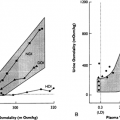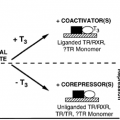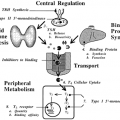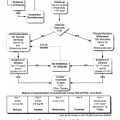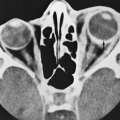NORMAL CONTROL OF PROLACTIN SECRETION
Part of “CHAPTER 13 – PROLACTIN AND ITS DISORDERS“
Prolactin secretion is controlled by dual inhibitory and stimula-tory factors (Fig. 13-1). This hormone is unique among anterior pituitary hormones, because it is primarily regulated through tonic inhibition. Two decades of investigation have demonstrated the presence of one or more prolactin-inhibiting factors (PIFs).1
Dopamine is the most important PIF described. Multiple studies support the hypothesis that dopamine acts as an inhibiting factor. In vitro studies reveal that high-affinity dopamine receptors (D2) are present on lactotrope membranes, and after binding occurs, inhibition of adenylate cyclase is demonstrated.2,3 This results in a decrease in cyclic adenosine mono-phosphate (cAMP) production and the release of prolactin. Dopamine also directly inhibits prolactin
biosynthesis at the level of RNA transcription. Dopamine is produced in higher nuclei in the brain and is secreted into the portal circulation to reach the pituitary. Infusion of dopamine in humans, resulting in serum dopamine concentrations similar to those found in portal blood, causes a reduction in prolactin secretion.4 Dopa-mine receptor blockade results in prolactin elevation.5 After dopamine is removed, as during pituitary stalk section, prolactin is rapidly released. These studies all point to a direct inhibitory effect of dopamine on pituitary lactotrope secretion. Most pharmacologic agents that cause prolactin release act either by blockade of dopamine receptors (e.g., haloperidol, phenothia-zines) or by dopamine depletion in the tuberoinfundibular neurons (e.g., reserpine, α-methyldopa).
biosynthesis at the level of RNA transcription. Dopamine is produced in higher nuclei in the brain and is secreted into the portal circulation to reach the pituitary. Infusion of dopamine in humans, resulting in serum dopamine concentrations similar to those found in portal blood, causes a reduction in prolactin secretion.4 Dopa-mine receptor blockade results in prolactin elevation.5 After dopamine is removed, as during pituitary stalk section, prolactin is rapidly released. These studies all point to a direct inhibitory effect of dopamine on pituitary lactotrope secretion. Most pharmacologic agents that cause prolactin release act either by blockade of dopamine receptors (e.g., haloperidol, phenothia-zines) or by dopamine depletion in the tuberoinfundibular neurons (e.g., reserpine, α-methyldopa).
Another potential PIF includes a 56-amino-acid PIF identified within the precursor for gonadotropin-releasing hormone (GnRH). This GnRH-associated peptide (GAP) inhibits prolactin secretion and reduces prolactin secretion in rats, but the role of GAP in modulating prolactin secretion in humans remains unconfirmed.6 Data also support the role of γ-aminobutyric acid (GABA) as a PIF. GABA is secreted into the portal circulation, with a resulting inhibitory effect on prolactin secretion, and GABA receptors have been detected on lactotropes.7 However, the physiologic importance of GABA in prolactin regulation is unclear.
Stay updated, free articles. Join our Telegram channel

Full access? Get Clinical Tree



